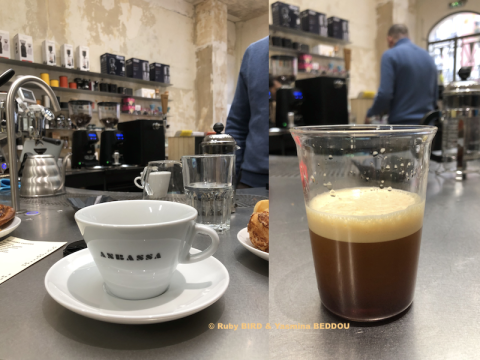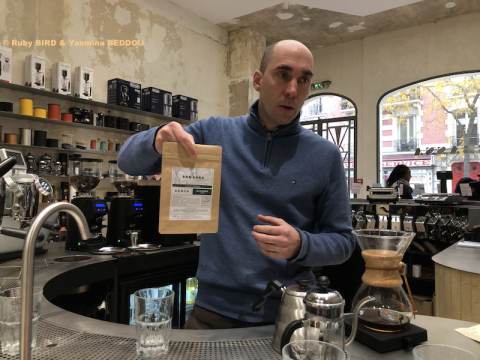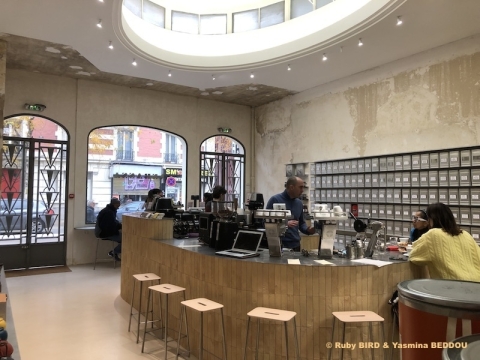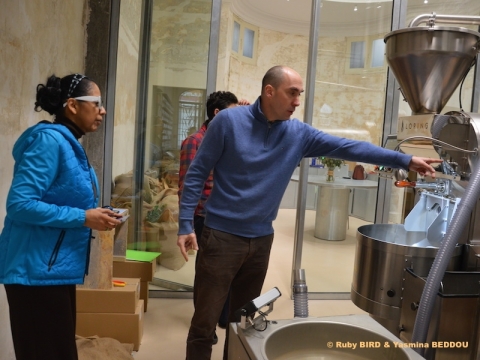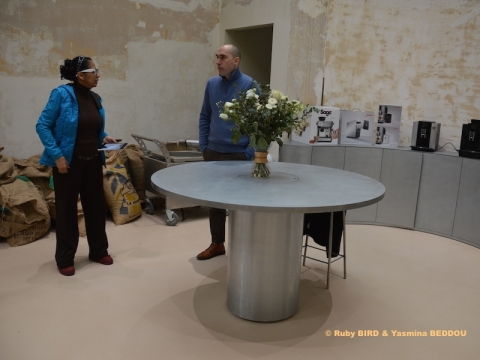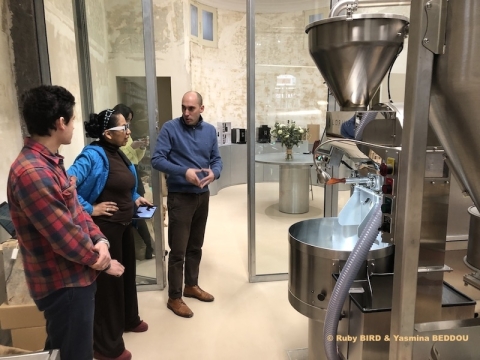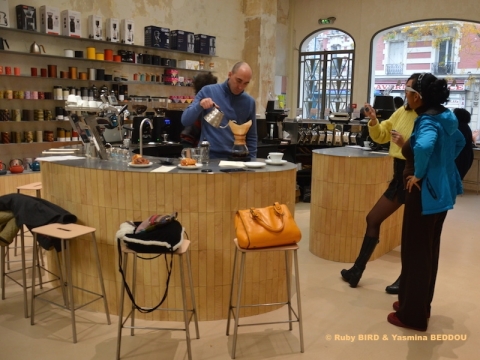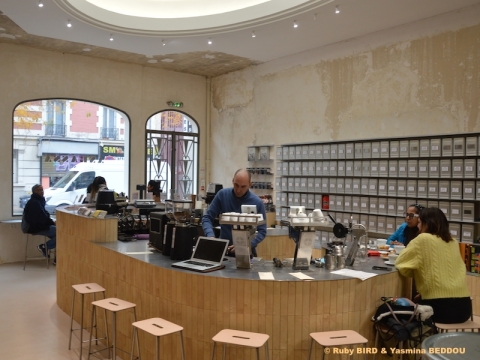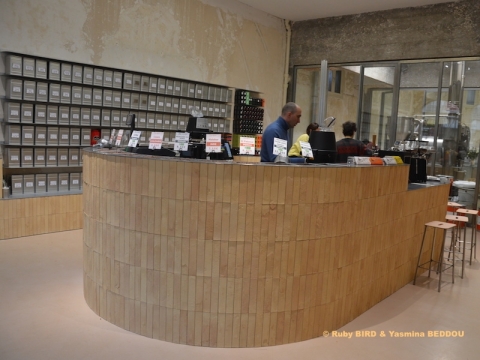Lifestyle
ANBASSA ROASTER SINCE 2007 & MEMBER OF THE CULINARY COLLEGE OF FRANCE SINCE 2016
DESIGNED BY OFFICE ABRAMI ROJAS

Anbassa - Sylvain CHAUVINEAU Co-Founder (Source: © Ruby BIRD & Yasmina BEDDOU)
USPA NEWS -
It is in a Magnificent Building from the 1930s in the Heart of Pantin that Anbassa, Roaster since 2007 and Member of the Culinary College of France since 2016, is opening a New Workshop-Boutique designed by the Office Abrami Rojas, the Different Stages of which of the Roasting, Preparation and Tasting of Coffee, are staged. This Building steeped in History, whose Art Deco Style of the Facade is recognizable at a Glance and is Ideal for this Long-Term Project: a Place conducive to exchange, entirely dedicated to Coffee.
It is in a Magnificent Building from the 1930s in the Heart of Pantin that Anbassa, Roaster since 2007 and Member of the Culinary College of France since 2016, is opening a New Workshop-Boutique designed by the Office Abrami Rojas, the Different Stages of which of the Roasting, Preparation and Tasting of Coffee, are staged. This Building steeped in History, whose Art Deco Style of the Facade is recognizable at a Glance and is Ideal for this Long-Term Project: a Place conducive to exchange, entirely dedicated to Coffee.
Sylvain Chauvineau and Jacques Chamberbrillon, Long-Time Friends and Great Coffee Lovers, created Anbassa in 2007, a Company specializing in the Import of Grand Cru Coffees from Ethiopia. Their Desire to combine their Skills as an Importer with the Profession of Roaster led them to take over "Brûlerie de Melun" in 2011.
"Anbassa" means “Lion” in Amharic because the Company's Roots are in Ethiopia where they have established Links with Ethiopian Producers and Exporters in order to promote these Exceptional Wintages.This Association and the Recurrence of Purchases from Year to Year, their Concern to preserve Local Know-How and Biodiversity, have made it possible to structure an Original Sector.
Jacques Chamberbrillon is now established in Ethiopia where he specializes in Coffee Sourcing for the Company Belco. He remains closely associated with Sylvain Chauvineau who manages Anbassa's Activity in France.
- As Roasters
They are committed to the Artisanal Method which consists of Rigorous and Long Cooking (12-18 minutes) allowing the Coffee to develop its Aromas in an Ideal Way. Recent Technological Innovations have allowed them to perfect our Artisanal Mastery thanks to the Computer Management of Temperature Curves. An Experienced Craftsman remains Decisive in defining a Cooking Profile specific to each Origin.
They are committed to the Artisanal Method which consists of Rigorous and Long Cooking (12-18 minutes) allowing the Coffee to develop its Aromas in an Ideal Way. Recent Technological Innovations have allowed them to perfect our Artisanal Mastery thanks to the Computer Management of Temperature Curves. An Experienced Craftsman remains Decisive in defining a Cooking Profile specific to each Origin.
What we call Coffee is the Kernel of the Roasted Coffee Cherry. Green coffee must always be roasted as close as possible to Consumers because it declines in Aroma quickly. This is why the exported Raw Material is Green Coffee.
The Coffee Cherry appears after flowering and should preferably be picked by Hand in order to select only Ripe Fruits. Before becoming Green Coffee, the Cherries must undergo a certain number of Treatments. For this, there are Several Techniques specific to each Terroir and linked to the Taste Characteristics that we wish to bring to the Coffee.
- Natural Coffee
The most common Practice is Dry Treatment. The Coffee is then called “Natural”. The Coffee Cherries are directly dried on specially designed beds or on concrete. It often takes Several Weeks for the Pulp to solidify and the Grain can then be hulled. This Method has an Ecological Advantage, it allows you to do without Water. Natural Coffees are often more Intense than washed Coffees.
The most common Practice is Dry Treatment. The Coffee is then called “Natural”. The Coffee Cherries are directly dried on specially designed beds or on concrete. It often takes Several Weeks for the Pulp to solidify and the Grain can then be hulled. This Method has an Ecological Advantage, it allows you to do without Water. Natural Coffees are often more Intense than washed Coffees.
- Washed Coffee
Washed Coffees undergo wet processing. It is often considered the Noblest Process because it produces Green Beans Free of Parchment Residue (Thin Skin enveloping the Coffee Bean). Once harvested, the Cherries are immediately pulped in Suitable Machines. The Grains obtained are then fermented in Washing Tanks and stirred for between 12 and 36 Hours before being dried. Washed Coffees have a Characteristic Acidity and are most of the Time more balanced than Natural Ones.
Washed Coffees undergo wet processing. It is often considered the Noblest Process because it produces Green Beans Free of Parchment Residue (Thin Skin enveloping the Coffee Bean). Once harvested, the Cherries are immediately pulped in Suitable Machines. The Grains obtained are then fermented in Washing Tanks and stirred for between 12 and 36 Hours before being dried. Washed Coffees have a Characteristic Acidity and are most of the Time more balanced than Natural Ones.
- Honey
The Honey Process is a Recent Method halfway between Washed and Natural. The Coffee Cherry is First pulped and then dried directly without going through Fermentation Tanks. Part of the Mucilage (Material surrounding the Grain) is still present during drying. This Method makes it possible to absorb the Sugar present in the Mucilage and gain Finesse compared to Natural Processing. Honey Coffee is recognizable by its Sweetness or Softness.
The Honey Process is a Recent Method halfway between Washed and Natural. The Coffee Cherry is First pulped and then dried directly without going through Fermentation Tanks. Part of the Mucilage (Material surrounding the Grain) is still present during drying. This Method makes it possible to absorb the Sugar present in the Mucilage and gain Finesse compared to Natural Processing. Honey Coffee is recognizable by its Sweetness or Softness.
- Other Methods
Other Variations can be made to these Techniques depending on the Anthropological and Historical Specificities linked to each Terroir. For example, Kenya inherited from the British an Original Method of processing Coffee Cherries, known as "Kenyan Washing" or "Double Washing" which consists of bathing the Cherries successively in two Fermentation Tanks before soaking and drying. In Indonesia, the Semi-Wet Method is often practiced, which consists of a Quick Wash between pulping and drying.
Other Variations can be made to these Techniques depending on the Anthropological and Historical Specificities linked to each Terroir. For example, Kenya inherited from the British an Original Method of processing Coffee Cherries, known as "Kenyan Washing" or "Double Washing" which consists of bathing the Cherries successively in two Fermentation Tanks before soaking and drying. In Indonesia, the Semi-Wet Method is often practiced, which consists of a Quick Wash between pulping and drying.
- About Tea
The Scientific Name of the Tea Plant is Camellia Sinensis. In the Wild, it can reach around Twenty Meters and live for Several Thousand Years. But mostly cultivated it does not exceed 1m50 to facilitate picking which is most often Manual.
The Scientific Name of the Tea Plant is Camellia Sinensis. In the Wild, it can reach around Twenty Meters and live for Several Thousand Years. But mostly cultivated it does not exceed 1m50 to facilitate picking which is most often Manual.
According to Legend,T was discovered by a Chinese Emperor who sat under a Tea Tree and received a Leaf carried by the Wind into his Cup of Hot Water in 2737 BC.... Other Countries such as India and Japan have their Founding Legend.... In the 19th Century, to counter the Chinese Monopoly, Tea was planted on a Large Scale in India and Ceylon. After China, India with Darjeling and Assam then Sri Lanka (formerly Ceylon) have become the main Tea Producers in the World. But since the 20th Century, other Countries have become increasingly important in Tea Production, such as Kenya and, more confidentially, Nepal, Malawi and Rwanda.
With a Long Tradition, Japan and Taiwan are distinguished by the Quality of their Teas. Taiwan is renowned for a lesser-known Category of Tea, Oolong, making it the Leading Producer of Blue-Green Tea. Japan grows 95% Green Teas, the best known of which are Sencha, Gyokuro and Matcha.
- The Type Of Tea
The Type of Tea and the Color of the Liquor do not depend on the Species of Tea Plant but on the Different Treatments and Transformations applied to the Harvested Leaves. To obtain Tea as Anbassa sells it, the Leaves of the Tea Plant must undergo a certain number of Transformations. The Different Manufacturing Processes allow the Company to distinguish 6 Types of Tea coming from the Same Plant. The Beverages obtained from these 6 Types each have their Specific Color.
The Type of Tea and the Color of the Liquor do not depend on the Species of Tea Plant but on the Different Treatments and Transformations applied to the Harvested Leaves. To obtain Tea as Anbassa sells it, the Leaves of the Tea Plant must undergo a certain number of Transformations. The Different Manufacturing Processes allow the Company to distinguish 6 Types of Tea coming from the Same Plant. The Beverages obtained from these 6 Types each have their Specific Color.
* Black or Red Tea
We speak of Black Tea to describe the Teas most consumed in the West, the Color of the Transformed Leaves of which is Black. In China, they are called Red Teas in reference to the Colour of the Liquor.
We speak of Black Tea to describe the Teas most consumed in the West, the Color of the Transformed Leaves of which is Black. In China, they are called Red Teas in reference to the Colour of the Liquor.
* Green Tea
Countries with long Traditions such as China or Japan consume Tea almost exclusively Green, which corresponds to the Way the Leaves were originally prepared. This Preparation aims to avoid any start of Oxidation.
Countries with long Traditions such as China or Japan consume Tea almost exclusively Green, which corresponds to the Way the Leaves were originally prepared. This Preparation aims to avoid any start of Oxidation.
* White Tea
The Process for obtaining White Tea is very Simple and yet very Delicate. The Tea should be harvested as the Buds open. The Leaves are Fragile and must be handled with Great Care.
The Process for obtaining White Tea is very Simple and yet very Delicate. The Tea should be harvested as the Buds open. The Leaves are Fragile and must be handled with Great Care.
* The Oolongs
Oolong is the Tea that undergoes the most processing, hence its High Price. There are Two Types of Oolong, the one whose Leaves have undergone 10 to 15% Oxidation (Blue-Green Teas), the one with 70% Oxidized Leaves (Black Color). Oolongs mainly come from Taiwan and China. They are appreciated for their Refreshing Character, the Absence of Bitterness and for their Aromas ranging from Floral Scent for the less Oxidized to Woody for others.
Oolong is the Tea that undergoes the most processing, hence its High Price. There are Two Types of Oolong, the one whose Leaves have undergone 10 to 15% Oxidation (Blue-Green Teas), the one with 70% Oxidized Leaves (Black Color). Oolongs mainly come from Taiwan and China. They are appreciated for their Refreshing Character, the Absence of Bitterness and for their Aromas ranging from Floral Scent for the less Oxidized to Woody for others.
* Yellow Tea
Yellow Tea is Chinese Green Tea that has undergone a Fermentation Phase. Made from the Highest Quality Leaves of the Tea Plant, Yellow Teas are among the Highest Grades of Tea.
Yellow Tea is Chinese Green Tea that has undergone a Fermentation Phase. Made from the Highest Quality Leaves of the Tea Plant, Yellow Teas are among the Highest Grades of Tea.
* Pu Erh Tea
Pu Erh is a surprising Tea from the Yunnan Region of China. It is also called Dark Tea or Black Tea because of the Color of its Liquor. The Particularity of this Tea lies in the Way its Leaves are aged. Pu Erh are often preserved in the Form of Compacted Leaf Cakes. They have the Particularity of improving with time and certain Old Wines can reach Pharaonic Prices. They are renowned for their Digestive Properties and for Detoxifying the Body. They are Powerful and are characterized by Aromas of Undergrowth (Bark, Damp Earth).
Pu Erh is a surprising Tea from the Yunnan Region of China. It is also called Dark Tea or Black Tea because of the Color of its Liquor. The Particularity of this Tea lies in the Way its Leaves are aged. Pu Erh are often preserved in the Form of Compacted Leaf Cakes. They have the Particularity of improving with time and certain Old Wines can reach Pharaonic Prices. They are renowned for their Digestive Properties and for Detoxifying the Body. They are Powerful and are characterized by Aromas of Undergrowth (Bark, Damp Earth).
Source: Opening of the New Workshop-Boutique in Pantin
With the Presence of Sylvain Chauvineau - Co-Founder of Anbassa
Ruby BIRD
http://www.portfolio.uspa24.com/
Yasmina BEDDOU
http://www.yasmina-beddou.uspa24.com/
With the Presence of Sylvain Chauvineau - Co-Founder of Anbassa
Ruby BIRD
http://www.portfolio.uspa24.com/
Yasmina BEDDOU
http://www.yasmina-beddou.uspa24.com/
more information: https://anbassa.fr
Ruby Bird Yasmina Beddou Paris Workshop Boutique Coffee Tea Producers Tasting Ethiopia China India Sri Lanka Natural Black Red Green White Vintage Exporters Roaster Culinary College Of France Jacques Chambrillon Sylvain Chauvineau Preparation Anbassa
Liability for this article lies with the author, who also holds the copyright. Editorial content from USPA may be quoted on other websites as long as the quote comprises no more than 5% of the entire text, is marked as such and the source is named (via hyperlink).

